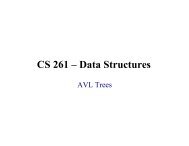Engineering Education and the Development of Expertise - Classes
Engineering Education and the Development of Expertise - Classes
Engineering Education and the Development of Expertise - Classes
You also want an ePaper? Increase the reach of your titles
YUMPU automatically turns print PDFs into web optimized ePapers that Google loves.
Journal <strong>of</strong> <strong>Engineering</strong> <strong>Education</strong> 100 (January 2011) 1<br />
Context-rich, multifaceted problems. Using context-rich, multifaceted problems has<br />
been advocated by several groups as an approach to having students develop more sophisticated<br />
problem solving skills than those developed when solving typical textbook exercises.<br />
This approach supports <strong>the</strong> development <strong>of</strong> key skills <strong>and</strong> <strong>the</strong> ability to apply conceptual<br />
knowledge both <strong>of</strong> which are needed to address <strong>the</strong> complex problems typical <strong>of</strong> engineering<br />
practice. Thus, this learning experience acts as a bridging strategy from textbook problems<br />
to realistic problems. The contexts <strong>of</strong> <strong>the</strong> problems can be chosen to link to students’<br />
interests <strong>and</strong> career plans, increasing students’ motivation as well.<br />
Ogilvie (2009) describes multifaceted problems as problems that “lie somewhere between<br />
well-structured problems found in textbooks <strong>and</strong> large, ill-defined, open-ended<br />
challenges in <strong>the</strong> degree-<strong>of</strong>-difficulty <strong>the</strong>se pose to students” (p. 3). A key characteristic <strong>of</strong><br />
multifaceted problems is that <strong>the</strong>y require students to integrate multiple concepts to construct<br />
a solution. Thus, students cannot use usual strategies <strong>of</strong> seeking examples in textbooks<br />
to identify <strong>the</strong> particular algorithm to solve <strong>the</strong> problem.<br />
Ogilvie (2009) presents <strong>the</strong> following example <strong>of</strong> a multifaceted problem related to<br />
<strong>the</strong>rmodynamics:<br />
You are in charge <strong>of</strong> drinks at a picnic that will start at 3pm. You place ice inside a<br />
cooler at 6am, when <strong>the</strong> temperature outside is 10C. The day is forecast to warm<br />
up steadily to reach 30C by 3pm. Estimate how much ice you will need (p. 3).<br />
Because students are likely to have little experience in solving such problems, teaching<br />
in <strong>the</strong> course should include specific instruction on how to approach <strong>the</strong>se problems. The<br />
complexity <strong>of</strong> <strong>the</strong> problems makes <strong>the</strong>m well-suited to group problem solving activities.<br />
In describing his use <strong>of</strong> context-rich, multifaceted problems in an introductory physics<br />
course, Ogilvie (2009) indicates that he uses <strong>the</strong>se strategies. The problems serve as a “capstone”<br />
experience for each <strong>of</strong> <strong>the</strong> main sections <strong>of</strong> <strong>the</strong> course; over <strong>the</strong> course <strong>of</strong> <strong>the</strong> semester<br />
<strong>the</strong> students solve six such problems. The instructor solved several <strong>of</strong> <strong>the</strong>se problems during<br />
class to model strategies that students could apply in <strong>the</strong>ir own problem solving. The students<br />
worked in groups <strong>of</strong> two or three to solve <strong>the</strong> multifaceted problems during recitation with<br />
support from a graduate teaching assistant (GTA). The GTAs received training on how to<br />
use questions that prompted thinking by <strong>the</strong> students ra<strong>the</strong>r than giving direct answers.<br />
In addition to solving context-rich, multifaceted problems in recitation, students had to<br />
solve this type <strong>of</strong> problem on two group exams. They were graded on <strong>the</strong>ir use <strong>of</strong> appropriate<br />
strategies, e.g., “representing <strong>the</strong> problem with a diagram <strong>and</strong> <strong>the</strong>ir description <strong>of</strong> ongoing<br />
monitoring <strong>of</strong> <strong>the</strong> progress <strong>of</strong> <strong>the</strong> solution” (Ogilvie, 2009, p. 4).<br />
The approach described by Ogilvie is well aligned with <strong>the</strong> characteristics <strong>of</strong> effective<br />
learning experiences listed in Table 1. It <strong>of</strong>fers students a challenge that forces <strong>the</strong>m to use<br />
<strong>the</strong>ir prior knowledge in new ways. It also presents problems in more realistic contexts that<br />
enhance <strong>the</strong> interest <strong>of</strong> students <strong>and</strong> uses collaborative approaches that encourage deeper<br />
engagement.<br />
Ogilvie evaluated <strong>the</strong> impact <strong>of</strong> this approach on students’ analysis strategies by collecting<br />
students’ reflections at <strong>the</strong> beginning <strong>and</strong> end <strong>of</strong> <strong>the</strong> semester in response to <strong>the</strong> following<br />
questions:<br />
Please reflect on how you approach physics problems. What methods do you use?<br />
What mistakes do you have to watch for? And are <strong>the</strong>se approaches similar to<br />
skills that you will need in your future studies or career? (p. 4)<br />
132
















